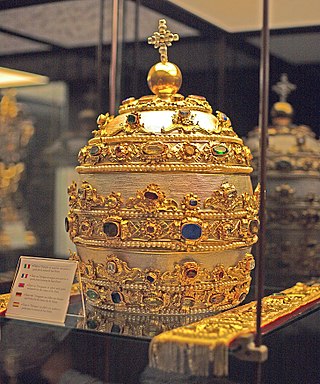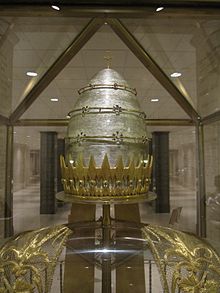
The papal tiara is a crown that is worn by popes of the Catholic Church from as early as the 8th century to the mid–20th century. It was last used by Pope Paul VI in 1963, and only at the beginning of his reign.

A papal coronation is the formal ceremony of the placing of the papal tiara on a newly elected pope. The first recorded papal coronation was of Pope Nicholas I in 858. The most recent was the 1963 coronation of Paul VI, who soon afterwards abandoned the practice of wearing the tiara. To date, none of his successors have used the tiara, and their papal inauguration celebrations have included no coronation ceremony, although any future pope may elect to restore the use of the tiara at any point during his pontificate.

The mitre or miter is a type of headgear now known as the traditional, ceremonial headdress of bishops and certain abbots in traditional Christianity. Mitres are worn in the Catholic Church, Eastern Orthodox Church, Oriental Orthodox Churches, the Anglican Communion, some Lutheran churches, for important ceremonies, by the Metropolitan of the Malankara Mar Thoma Syrian Church, and also, in the Catholic Church, all cardinals, whether or not bishops, and some Eastern Orthodox archpriests.
Universi Dominici gregis is an apostolic constitution of the Catholic Church issued by Pope John Paul II on 22 February 1996. It superseded Pope Paul VI's 1975 apostolic constitution, Romano Pontifici eligendo, and all previous apostolic constitutions and orders on the subject of the election of the pope.

A Papal Mass is the Solemn Pontifical High Mass celebrated by the Pope. It is celebrated on such occasions as a papal coronation, an ex cathedra pronouncement, the canonization of a saint, on Easter or Christmas or other major feast days.

Papal regalia and insignia are the official items of attire and decoration proper to the Pope in his capacity as the visible head of the Catholic Church and sovereign of the Vatican City State.

A papal conclave was held from 19 to 21 June 1963 to elect a successor of John XXIII, who had died on 3 June 1963. The cardinal electors assembled in Rome and, after six ballots, elected Cardinal Giovanni Battista Montini, Archbishop of Milan. He accepted the election and took the name Paul VI. Paul VI's coronation on 30 June was the last papal coronation to date.

A papal conclave took place from 25 to 28 October following the death of Pope Pius XII on 9 October 1958. On the eleventh ballot, the College of Cardinals elected Cardinal Angelo Giuseppe Roncalli as the new pope. He accepted the election and took the name John XXIII. He was the second patriarch of Venice to be elected pontiff in the 20th century after Pius X.

Papal inauguration is a liturgical service of the Catholic Church within Mass celebrated in the Roman Rite but with elements of Byzantine Rite for the ecclesiastical investiture of a pope. Since the inauguration of Pope John Paul I, it has not included the 820-year-old (1143–1963) papal coronation ceremony.

An enthronement is a ceremony of inauguration, involving a person—usually a monarch or religious leader—being formally seated for the first time upon their throne. Enthronements may also feature as part of a larger coronation rite.
Romano Pontifici eligendo was the apostolic constitution governing the election of popes that was promulgated by Pope Paul VI on 1 October 1975. It instituted a number of far-reaching reforms in the process of electing popes. It set the maximum number of electors at 120 and restated in a more formal context the rule he had already instituted that cardinals over the age of 80 not participate in electing a pope.

The State Crown of George I is the imperial and state crown crafted in 1714 for King George I. It was modified and used by subsequent monarchs until 1838. The empty gold frame and its aquamarine monde which dates from the reign of King James II are both part of the Crown Jewels of the United Kingdom. They are on public display in the Martin Tower at the Tower of London.

Some hold the conspiracy theory which asserts that the conservative Cardinal Giuseppe Siri, then the Archbishop of Genoa, was elected pope in the 1958 papal conclave, taking the name Pope Gregory XVII, but that his election was suppressed. Siri did not associate himself with this idea.

The Napoleon Tiara was a papal tiara given to Pope Pius VII in June 1805 a few months after he presided at the coronation of Napoleon I. While lavishly decorated with jewels, it was deliberately too small and heavy to be worn and meant as an insult to the Pope. In the painting of The Coronation of Napoleon by Jacques-Louis David, the tiara is held behind the Pope by one of his aides.

A canonical coronation is a pious institutional act of the pope, duly expressed in a formal decree of a papal bull, in which the pope bestows the pontifical right to impose an ornamental crown, a diadem or an aureole to an image of Christ, Mary or Joseph that is widely venerated in a particular diocese or locality. The act was later regulated to Marian images only, through the De coronatione imaginum B.V. Mariae that was issued on 25 March 1973.

Queen Elizabeth II owned a historic collection of jewels – some as monarch and others as a private individual. They are separate from the gems and jewels of the Royal Collection, and from the coronation and state regalia that make up the Crown Jewels.
The Ceremonial of John XXIII was the last to use full papal ceremony, much of which was abolished subsequently after Vatican II.

Pontificalis Domus was a motu proprio document issued by Pope Paul VI on 28 March 1968, in the fifth year of his pontificate. It reorganized the Papal Household, which had been known until then as the Papal Court.

Pope Pius XII created 56 cardinals in two consistories. On both occasions Pius tried to bring the membership of the College of Cardinals to 70, the maximum established by Pope Sixtus V in 1586. The death of one cardinal meant his first consistory brought the College to 69 members, but his second consistory, through the prompt addition of another name after a cardinal-designate died, brought the number of cardinals to 70.

















